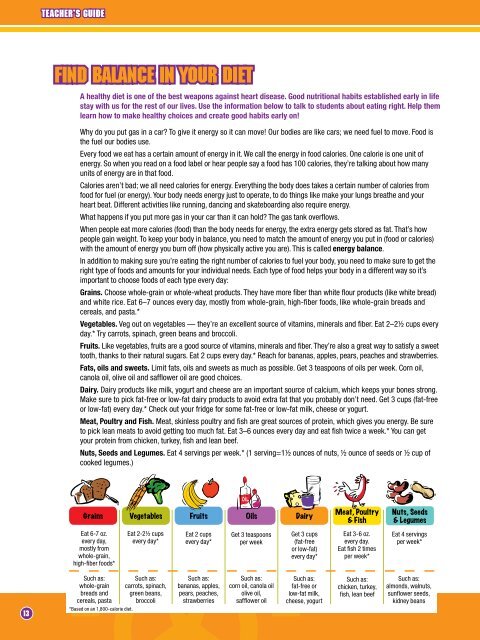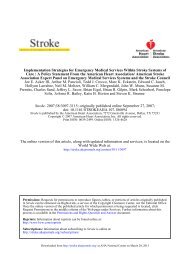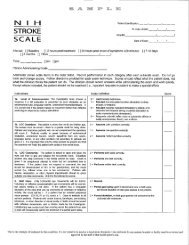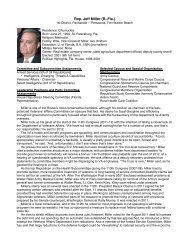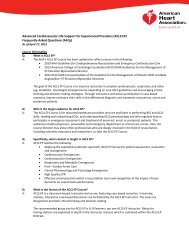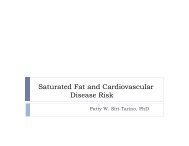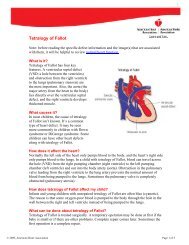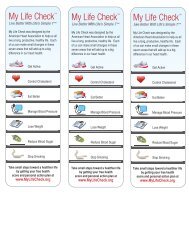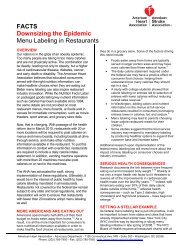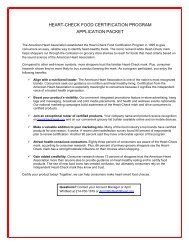Teacher's Resource Guide - American Heart Association
Teacher's Resource Guide - American Heart Association
Teacher's Resource Guide - American Heart Association
You also want an ePaper? Increase the reach of your titles
YUMPU automatically turns print PDFs into web optimized ePapers that Google loves.
teacher’s <strong>Guide</strong><br />
Find Balance in Your Diet<br />
A healthy diet is one of the best weapons against heart disease. Good nutritional habits established early in life<br />
stay with us for the rest of our lives. Use the information below to talk to students about eating right. Help them<br />
learn how to make healthy choices and create good habits early on!<br />
Why do you put gas in a car? To give it energy so it can move! Our bodies are like cars; we need fuel to move. Food is<br />
the fuel our bodies use.<br />
Every food we eat has a certain amount of energy in it. We call the energy in food calories. One calorie is one unit of<br />
energy. So when you read on a food label or hear people say a food has 100 calories, they’re talking about how many<br />
units of energy are in that food.<br />
Calories aren’t bad; we all need calories for energy. Everything the body does takes a certain number of calories from<br />
food for fuel (or energy). Your body needs energy just to operate, to do things like make your lungs breathe and your<br />
heart beat. Different activities like running, dancing and skateboarding also require energy.<br />
What happens if you put more gas in your car than it can hold? The gas tank overflows.<br />
When people eat more calories (food) than the body needs for energy, the extra energy gets stored as fat. That’s how<br />
people gain weight. To keep your body in balance, you need to match the amount of energy you put in (food or calories)<br />
with the amount of energy you burn off (how physically active you are). This is called energy balance.<br />
In addition to making sure you’re eating the right number of calories to fuel your body, you need to make sure to get the<br />
right type of foods and amounts for your individual needs. Each type of food helps your body in a different way so it’s<br />
important to choose foods of each type every day:<br />
Grains. Choose whole-grain or whole-wheat products. They have more fiber than white flour products (like white bread)<br />
and white rice. Eat 6–7 ounces every day, mostly from whole-grain, high-fiber foods, like whole-grain breads and<br />
cereals, and pasta.*<br />
Vegetables. Veg out on vegetables — they’re an excellent source of vitamins, minerals and fiber. Eat 2–2½ cups every<br />
day.* Try carrots, spinach, green beans and broccoli.<br />
Fruits. Like vegetables, fruits are a good source of vitamins, minerals and fiber. They’re also a great way to satisfy a sweet<br />
tooth, thanks to their natural sugars. Eat 2 cups every day.* Reach for bananas, apples, pears, peaches and strawberries.<br />
Fats, oils and sweets. Limit fats, oils and sweets as much as possible. Get 3 teaspoons of oils per week. Corn oil,<br />
canola oil, olive oil and safflower oil are good choices.<br />
Dairy. Dairy products like milk, yogurt and cheese are an important source of calcium, which keeps your bones strong.<br />
Make sure to pick fat-free or low-fat dairy products to avoid extra fat that you probably don’t need. Get 3 cups (fat-free<br />
or low-fat) every day.* Check out your fridge for some fat-free or low-fat milk, cheese or yogurt.<br />
Meat, Poultry and Fish. Meat, skinless poultry and fish are great sources of protein, which gives you energy. Be sure<br />
to pick lean meats to avoid getting too much fat. Eat 3–6 ounces every day and eat fish twice a week.* You can get<br />
your protein from chicken, turkey, fish and lean beef.<br />
Nuts, Seeds and Legumes. Eat 4 servings per week.* (1 serving=1½ ounces of nuts, ½ ounce of seeds or ½ cup of<br />
cooked legumes.)<br />
Grains Vegetables Fruits Oils Dairy<br />
Eat 6-7 oz.<br />
every day,<br />
mostly from<br />
whole-grain,<br />
high-fiber foods*<br />
Eat 2-2½ cups<br />
every day*<br />
Eat 2 cups<br />
every day*<br />
Get 3 teaspoons<br />
per week<br />
Get 3 cups<br />
(fat-free<br />
or low-fat)<br />
every day*<br />
Meat, Poultry<br />
& Fish<br />
Eat 3-6 oz.<br />
every day.<br />
Eat fish 2 times<br />
per week*<br />
Nuts, Seeds<br />
& Legumes<br />
Eat 4 servings<br />
per week*<br />
13<br />
Such as: Such as:<br />
whole-grain carrots, spinach,<br />
breads and green beans,<br />
cereals, pasta broccoli<br />
*Based on an 1,800-calorie diet.<br />
Such as:<br />
bananas, apples,<br />
pears, peaches,<br />
strawberries<br />
Such as:<br />
corn oil, canola oil<br />
olive oil,<br />
safflower oil<br />
Such as:<br />
fat-free or<br />
low-fat milk,<br />
cheese, yogurt<br />
Such as:<br />
chicken, turkey,<br />
fish, lean beef<br />
Such as:<br />
almonds, walnuts,<br />
sunflower seeds,<br />
kidney beans


